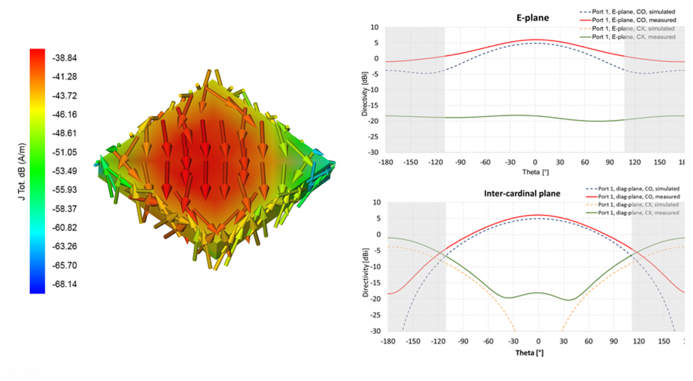-
StatusCompleted
-
Status date2020-02-04
-
Activity Code5B.086
Aim of the AISMAN project is to design, manufacture and test a miniaturized space array antenna suitable for SAT-AIS application.
Miniaturization is understood as a technique to reduce the size of the antenna in stowed configuration. Both techniques to reduce the physical dimensions of the single-element antenna and techniques to fold/deploy the final array antenna aperture have been considered.
After trade-offs at element and array level, a miniaturized antenna element, working at VHF frequencies and suitable for AIS applications, has been studied, designed, manufactured and extensively tested.
The design process has been refined and validated through experimental measurements, providing a valuable design tool for further antenna design steps. The element design is extremely flexible, and several parameters can be optimized according to mission needs.
After trade-off at array level, considering different satellite platforms, the antenna element has been also tested in embedded array configuration, with inclusion of a satellite mock-up, and compliance to the array requirements has been demonstrated. Furthermore, excellent matching has been achieved between simulated and measured data, both at element and at array level, confirming the robustness of the design process.

A parallel study on DBF techniques has been carried out. Static DBF has been pre-selected as preferred technique to be used in SAT-AIS applications.
An additional activity (CCN-01) has led to the design, manufacturing and full test (RF & thermal) of an improved antenna element, moving a step closer to flight model production.
The test outcomes show that the initial trade-offs could result in different element selection if driven by specific mission requirements. Such requirements can set different weights to the trade-off marking, driving the selection of the element accordingly. The flexibility of the element design allows accommodating this selection process.

The following outcomes from CCN activities on improved element design can be highlighted:
- Antenna performance parameters can be adapted according to driving requirements for specific mission (for example, mass & thickness can weight differently with respect to mechanical robustness & RF performances)
- Results from thermal tests show that:
- A first thermal cycling acts as “stabilization” on the antenna, as it is currently mechanically assembled.
- RF bandwidth shall be enlarged to cope with possible shifts in resonance frequency, unless specific thermal control is implemented on each antenna element.
- Changing technology (from fully metallic to sandwich) may have affected the initial trade-off at element level; another element design (e.g. patch element) could be less sensitive in combination with sandwich technology.
- Trade-off on technology might also be revisited taking into account CCN outcomes: hybrid solutions may be envisaged (for example, fully metallic architecture but using electro-plated skins).
Finally, a Design, Development and Test Plan has been prepared, with proper estimation of non-recurring and recurring costs for a batch production of up to 30 FM items.
Concerning ways forward for the AISMAN project, it is clear that further iterations are necessary to increase TRL of both antenna element and array configuration. Among those (but not limited to):
- element design evolution and optimization
- refinement of manufacturing processes
- environmental test campaign for element qualification (vibration, shock, TVAC)
- array coverage tuned according to number of elements & beams
These iterations shall be driven by specific mission requirements.
Additional technological development activities can be proposed to further investigate other candidate elements which have shown high potentialities in terms of RF performances, but have been discarded at initial trade-off stage.
Possible funding opportunity can be sought under (ARTES 5.2 + ARTES 3-4) and (GSTP 6.2) budgets at ESA level, as well as with private funding at satellite providers level.
AISMAN outcomes can be contextualized in the frame of the European SAT-AIS initiative, that aims at providing a space-based complementary system to extend the range of the existing AIS system to high seas via a satellite constellation in VHF band.
The success of this activity is the demonstration that VHF space applications can be accommodated on mini-satellite class platform, driving the design to a further stage.
A deployable VHF array antenna providing multi-beam full earth disk coverage through digital beam forming has been conceived thanks to the design of a miniaturized dual polarized element suitable for space applications, based on flat crossed dipoles, backed by an Artificial Magnetic Material. This design combined with a slotted ground plane has allowed a significant reduction in size and mass, maintaining high efficiency and low back radiation.
After the development and manufacturing of an EM of the full five elements array and satellite mock-up, final electrical testing campaigns have been successfully conducted using advanced testing methodologies and cutting-edge post-processing techniques based on EQC approach.
A further iteration on the mechanical and electrical design of the element has been conducted in order to improve the element mechanical robustness and further reduce the antenna element weight. An improved element based on a sandwich structure (two E-glass skins closing a honeycomb core, with metallic parts made by PCB) has been developed and manufactured. Validation campaigns have confirmed the expected results in terms of RF and mechanical performance.
The project was organized into two main phases:
- Phase 1, with the following tasks:
- Task 1: Consolidation of Antenna Requirements for AIS Applications
- Task 2. State-Of-The-Art on Miniaturized Low-Gain Single-Element Antennas
- Task 3: Array Antenna Architecture Trade-Off
- Task 4: Preliminary Array Antenna Design for AIS Applications
- Phase 2, with the following tasks:
- Task 5: Detailed Array Antenna Design for AIS Applications
- Task 6: Manufacturing of the EM Array Antenna for AIS Applications
- Task 7: Testing of the EM Array Antenna for AIS Applications
- Task 8: Review of Achievement and Improvements
A further phase (Task 9: Design, Manufacturing and Test of Improved Antenna Element) was awarded by CCN-01, for further iteration on the mechanical and electrical design of the element in order to improve the element mechanical robustness and further reduce the antenna element weight.




